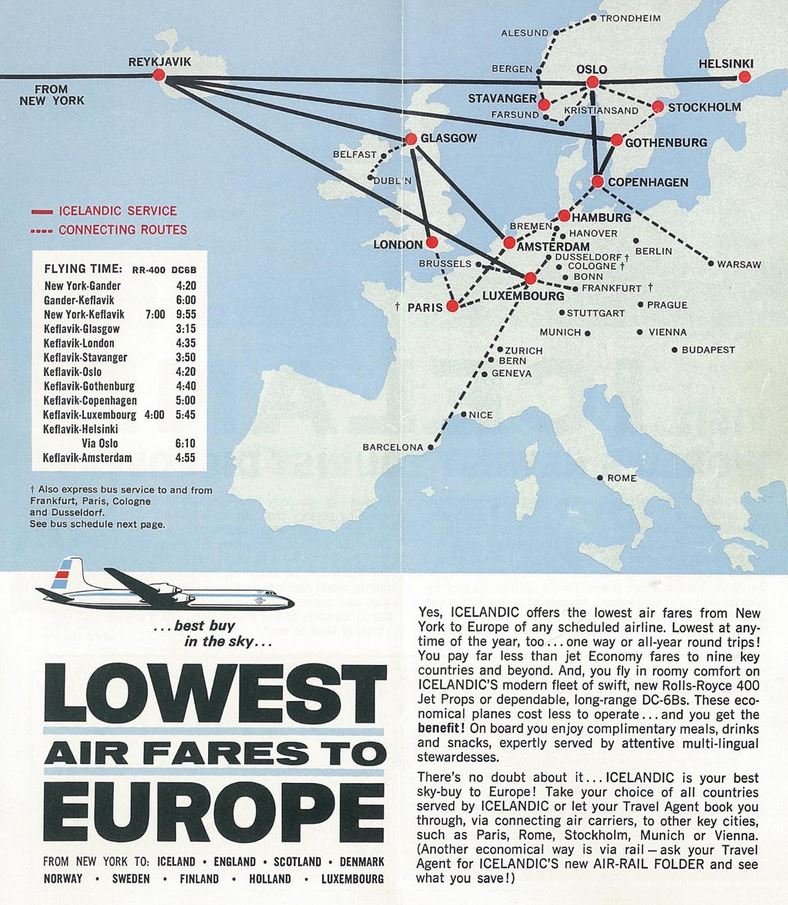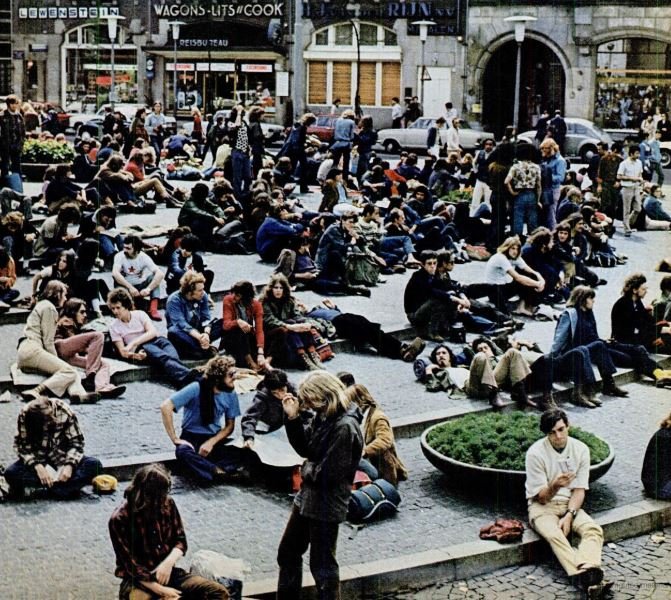
Flying the Hippie Airlines
By 1971 I had hitchhiked around virtually every corner of North America except the American deep south, meeting people of all kinds and travelling through mountains, deserts, the prairies, the bible belt and the great plains, plus visiting many of the continent’s big cities and basking in that California sun. Now, it was time for something new and different – Europe. I was excited by the idea of experiencing different cultures and interacting with the local people, but a little worried about how I would get by in countries where the people spoke different languages.
What I really wanted was to attend the University of Alberta, but I was stymied by a ridiculous ruling by the Edmonton Public School Board which only gave me credit for two years of Latin, when I had completed three years at an outstanding New Jersey high school and got my best grades in that subject. I needed three years of a foreign language to gain admission to the university and at that time no Edmonton public school offered Latin. The only way to take it was by correspondence, the worst imaginable way to learn a language. They were totally wrong, but I think they did me an unintentional favour. The absurd four-year delay in my acceptance to the U of A left me free to travel a significant portion of the world, work at various kind of jobs, meet interesting people of all kinds, and frankly, grow up, though I still joke that immaturity keeps me young. I believe my eight-month journey across Europe and Africa broadened me as a person as I met wonderful people of all ages and cultures, saw firsthand the conditions people lived in, in the Third World, and developed a hunger for higher education that continues to drive me.
1971 was a golden year for budget backpackers. A number of fare reductions by airlines and the Eurail consortium made travel from North America to and across Europe far more economical, and seven hundred and fifty thousand very happy American and Canadian young people took advantage and flooded into Europe to spend the summer, or even longer, a trend that continued for most of the decade. Eurail introduced a liberally interpreted student second- class, two-month train pass for $125, which clever backpackers craftily used to book overnight train rides for a free place to sleep. Air fares from North America to Europe were cut heavily, mostly under pressure from Icelandic Airways (aka Loftleider), with stunning reductions, which many people took advantage of, including Bill and Hillary Clinton. And me. I could not resist their US$169 one-year open, round-trip ticket from New York City to Luxembourg, and hitchhiked down from Prince Edward Island to my parents’ place in northeastern New Jersey to book the flight.

Icelandic was quickly dubbed “The Hippie Airline,” a title which the company happily embraced. It adopted the slogan “We are the Slowest but the Lowest,” because of the mandatory multi-hour layover in Reykjavik’s airport and their rock bottom fares. Icelandic was not a member of the International Air Transport Association (IATA), so it could set prices as low as it liked. Pan Am responded with a round-trip ticket to Europe for US$220. Other airlines not only lowered their cross-Atlantic prices but offered major reductions on last-minute ticket purchases to fill any remaining empty seats. Everybody won. The airlines made very solid profits and North American youths got to cruise around Europe, enjoy the wealth of public art, a dizzying array of cultures, and a deep sense of history and tradition. The European countries also enjoyed an economic boost and even added a new Interrail Pass especially for European youth, so more of them could join the party.
I had never flown before, but eagerly boarded my Icelandic flight to Luxembourg, August 27, 1971. I had saved most of the money I earned working for nearly a year in Prince Edward Island and was braced for a long journey which would end only when I ran out of money. At least that was the plan. My first destination was Amsterdam, the capital city of the continent for the tidal wave of young North American backpackers. I was so excited about the idea of travelling from country to country and interacting with Europeans that I got little sleep on the flights and arrived in Luxembourg dead tired. I walked out of the airport, sat down in a grassy place beside a nearby building and promptly fell asleep. I hope I didn’t snore. I woke up a few hours later, feeling refreshed and immediately began hitchhiking the 400 kilometres to Amsterdam. I made it there before dark, checked in at a local youth hostel and began exploring my first true international city, unless you count The Big Apple, which I grew up 30 minutes away from. I was particularly struck by hordes of cyclists mingling with the crowded Amsterdam car traffic. It looked like fun. I rented a bike the next day and was lucky to survive a few hours of madcap cycling.

I spent hours in Amsterdam’s wonderful art museums, exploring the works of Rembrandt, Van Gogh, Vermeer and many others. I made some friends at the hostel and we spent lots of time in Amsterdam’s hip cafes and bars. Marijuana was easily obtainable and de facto legal, but I opted out because I had lost any interest in getting high. I met a nice young Dutch woman who showed me around, but when I casually mentioned that the Dutch language sounded a bit like German, she angrily replied “We are not Germans! We do not sound like Germans!!” Obviously, I had a LOT to learn about Europeans and this was lesson one. Don’t mention the war. Or the Germans.

Personally, I loved the cheap air fares but declined to buy a Eurail pass and stuck with hitchhiking for a number of reasons. I wanted to go to places that weren’t covered by the Eurail pass. I spent almost seven full weeks in England, Scotland, Northern Ireland and the Republic of Ireland, none of which were included in the pass. I also hitchhiked through areas in countries covered by Eurail in which there were no rail lines. Unfortunately, hitchhiking was not a safe option for a lone woman or even two women, but as a male who had thumbed well over 70,000 kilometres in North America I felt perfectly safe. I also didn’t want to feel constant pressure to keep hopping on trains just to get the most out of a Eurail pass.
While hitchhiking across northwest Spain I discovered the small city of Santiago de Compestella, a fascinating place I liked so much I spent five weeks there, made lots of local friends, focused on learning Spanish, and got some real insight into ordinary lives; something that backpackers with a Eurail pass would almost certainly never have the time to do. I also found hitchhiking was the best way to meet local people because with two exceptions, everyone that picked me up was a European, leading to plenty of delightful interactions. In Ireland, for example, I thumbed rides a few times with friendly folks, who would eventually ask “Do you take a drink then?” Indeed I did and we would stop at the next pub for a pint or so and a friendly and spirited conversation, which was great because no one can talk like the Irish. Another Irishman who picked me up asked how often I got to eat meat at the hostels. Pretty much never, I replied honestly. He then stopped at a butcher shop in Gort and said “well, you’re going to have steak tonight.” He bought four pounds of quality steak for me, which I shared with the other travellers at the next hostel. Amazing. I even caught a ride with an Irish government minister and we had a lively conversation about life, politics and my Irish ancestry, until he dropped me off in Donegal town.
I also remember the gregarious French truck driver who kept passing me cookies as we laughed and talked in broken French and English as his truck rattled down the highway, and the crazy Italian driver in his hot car who blasted across northern Spain with his hand glued to the car horn as I looked on in horror and the locals jumped out of the way. For me, those interactions were almost pure delight. I have always believed that travelling is mostly about freedom, independence and being open to whatever ideas and opportunities come along. I enjoyed chatting with fellow backpackers but the real gold was connecting with Europeans. I had an impassioned political chat about colonialism with some university students in Portugal, a hot debate about Marxism with some Norwegian lefties in Oslo, and lots of talk about life and politics in Belfast with four young Catholics from Queens University, who invited me to stay with them and were great companions. Those were precisely the kinds of experiences I came to Europe to have and they will be described in greater detail in later posts.
Many backpackers, including me, used the very inexpensive system of youth hostels across the continent and found it to be a wonderful way to find a basic but comfortable place to stay, to meet other travellers and swap stories and tips. I also had a very good two-man tent which I used for emergencies. It was possible to get by on as little as $10-a-day and spend months, if not an entire year, touring the many highlights of Europe, making friends and meeting many interesting people. I did occasionally splurge a bit, attending a play, for example, at Dublin’s famous Abbey Theater, and Samuel Beckett’s play Endgame in Oslo, which was just as effective in Norwegian, because I knew it well. I also downed a few pints here and there and switched to wine in southern Europe, but generally I pinched my pennies hard.
Independent travel, with its scope for spontaneity, turned out to be a lot more fun and economical for young travellers than packaged tours. As winter approached the number of North American backpackers dwindled noticeably, but the more adventurous eventually made their way to Turkey, Iran and on to India or south to Africa. For budget backpackers it was the best time ever to be young and free. I didn’t know for sure how long my money would last, where I would end up and didn’t really care as long as I was having enjoyable and stimulating experiences. I could never have guessed my final destination, when I would come back to North America or why. I was too busy having the time of my life.
Feature image: Life Magazine, July 9, 1971